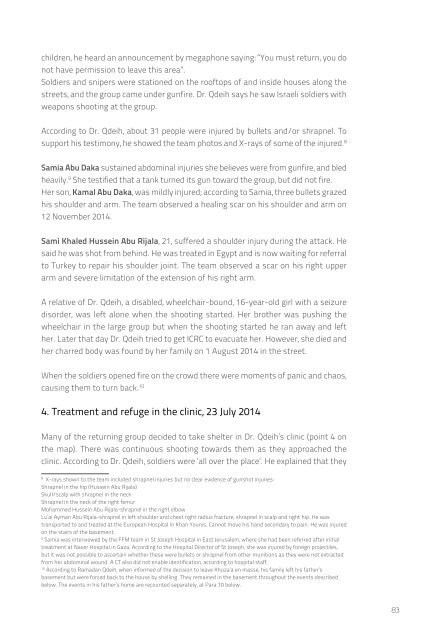HHo0s
HHo0s
HHo0s
You also want an ePaper? Increase the reach of your titles
YUMPU automatically turns print PDFs into web optimized ePapers that Google loves.
children, he heard an announcement by megaphone saying: “You must return, you donot have permission to leave this area”.Soldiers and snipers were stationed on the rooftops of and inside houses along thestreets, and the group came under gunfire. Dr. Qdeih says he saw Israeli soldiers withweapons shooting at the group.According to Dr. Qdeih, about 31 people were injured by bullets and/or shrapnel. Tosupport his testimony, he showed the team photos and X-rays of some of the injured. 8Samia Abu Daka sustained abdominal injuries she believes were from gunfire, and bledheavily. 9 She testified that a tank turned its gun toward the group, but did not fire.Her son, Kamal Abu Daka, was mildly injured; according to Samia, three bullets grazedhis shoulder and arm. The team observed a healing scar on his shoulder and arm on12 November 2014.Sami Khaled Hussein Abu Rijala, 21, suffered a shoulder injury during the attack. Hesaid he was shot from behind. He was treated in Egypt and is now waiting for referralto Turkey to repair his shoulder joint. The team observed a scar on his right upperarm and severe limitation of the extension of his right arm.A relative of Dr. Qdeih, a disabled, wheelchair-bound, 16-year-old girl with a seizuredisorder, was left alone when the shooting started. Her brother was pushing thewheelchair in the large group but when the shooting started he ran away and lefther. Later that day Dr. Qdeih tried to get ICRC to evacuate her. However, she died andher charred body was found by her family on 1 August 2014 in the street.When the soldiers opened fire on the crowd there were moments of panic and chaos,causing them to turn back. 104. Treatment and refuge in the clinic, 23 July 2014Many of the returning group decided to take shelter in Dr. Qdeih’s clinic (point 4 onthe map). There was continuous shooting towards them as they approached theclinic. According to Dr. Qdeih, soldiers were ‘all over the place’. He explained that they8X-rays shown to the team included shrapnel injuries but no clear evidence of gunshot injuries:Shrapnel in the hip (Hussein Abu Rijala)Skull/scalp with shrapnel in the neckShrapnel in the neck of the right femurMohammed Hussein Abu Rijala-shrapnel in the right elbowLu’ai Ayman Abu Rijala-shrapnel in left shoulder and chest right radius fracture, shrapnel in scalp and right hip. He wastransported to and treated at the European Hospital in Khan Younis. Cannot move his hand secondary to pain. He was injuredon the stairs of the basement.9Samia was interviewed by the FFM team in St Joseph Hospital in East Jerusalem, where she had been referred after initialtreatment at Naser Hospital in Gaza. According to the Hospital Director of St Joseph, she was injured by foreign projectiles,but it was not possible to ascertain whether these were bullets or shrapnel from other munitions as they were not extractedfrom her abdominal wound. A CT also did not enable identification, according to hospital staff.10According to Ramadan Qdeih, when informed of the decision to leave Khuza’a en masse, his family left his father’sbasement but were forced back to the house by shelling. They remained in the basement throughout the events describedbelow. The events in his father’s home are recounted separately, at Para 10 below.83


